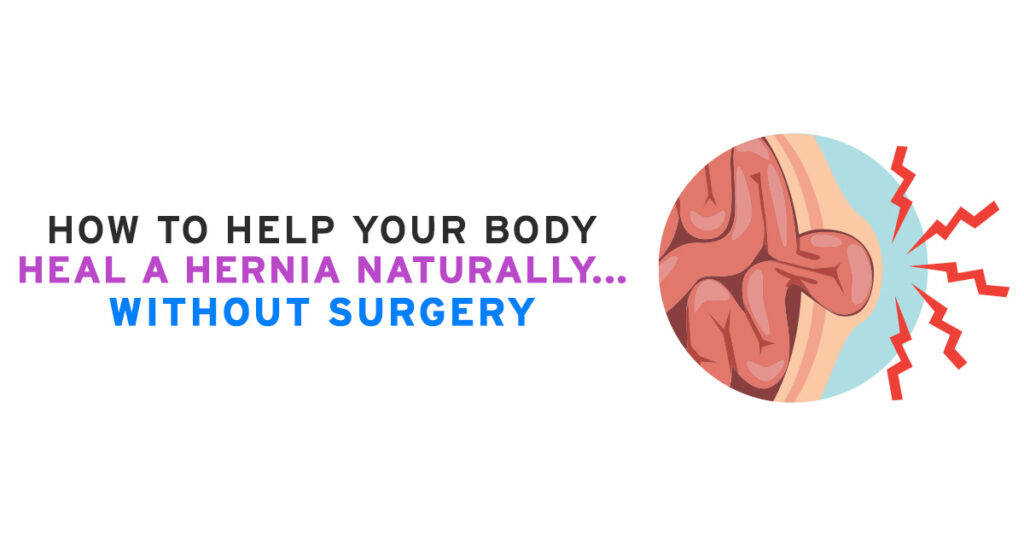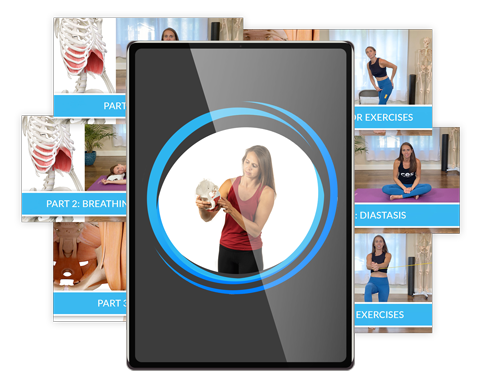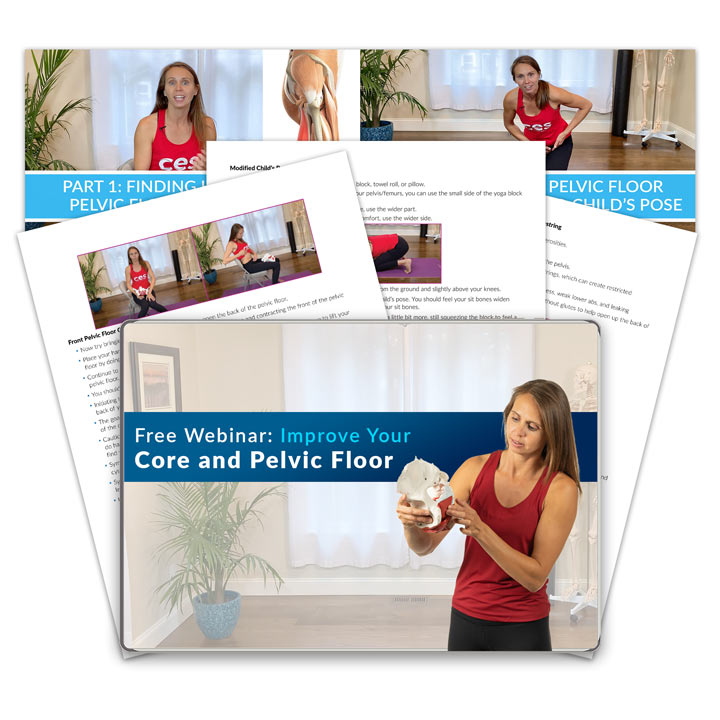Note from Sarah: In this guest blog post by Gina, she’s giving her personal natural umbilical hernia recovery story. Please be aware that some hernias require surgery immediately and can be life-threatening. Please check with your doctor before trying a non-surgical hernia repair approach and make sure it’s safe!
You're so smart to be considering natural hernia recovery options! A lot of folks make the misguided assumption that all they need to do for a hernia is get a repair, and then life will be smooth sailing once again. But many people find themselves in the predicament of developing multiple hernias over the years. Why? Because they never got to the root of the problem – their movement patterns, and how their bodies manage pressure.
Rehab can work to help heal a hernia in some people because our abdomen is designed to work as a system. If one part of our core system and how we manage pressure is out of balance, hernias can be the outcome.
Just how powerful can getting to the root of the problem be with corrective exercise? Glad you asked 😊 Hernia exercises can be so effective that 50% of people with hernias who opt not to have surgery go back to the activities they love! That's saying a lot! (1)
Having hernia repair surgery is like pushing the "reset" button on things. It gets you out of trouble today – but it doesn't address the issues in your body that led the hernia to develop in the first place. And not addressing those issues leaves you really vulnerable to future hernias. No repair can ensure that you won't have a repeat performance. However, the good news is that experts are out there who know exactly how to teach you to help heal from a hernia.
Why Do We Get Hernias?
- Some hernias are a result of surgery
- Others are a result of pregnancy
- Some hernias come from a sudden strain that our system isn’t equipped to handle
- Hernias can also develop simply from a lifetime of too much pressure
Most of us have a combination of factors that led to it. Don’t blame yourself! Sometimes circumstances are out of our control. Furthermore, you didn’t know what you didn’t know. We all have to learn some lessons the hard way from time to time! The good news is, no matter why or how you got your hernia, I promise you that corrective exercises can make a difference. The exercises are scalable, too – so you can do as much or as little as you want.
What is a Hernia, Exactly?
Before we dive into learning how to help a hernia naturally, let’s cover some definitions.
A hernia occurs when an organ or fatty tissue squeezes through a weak spot in surrounding muscle or a type of connective tissue called fascia. There are a number of different types of hernias. Today we will focus on hernias resulting from an incision as well as umbilical hernias, which are located near the belly button. Hernias happen to both men and women.
If you have a diastasis, you may be at a higher risk for a hernia since the fascia in your abdomen is already stretched and thinned. A diastasis is a thinning of the tissue between the rectus abdominis where it meets at the midline of your abdomen. You can read more about diastasis here, including causes and treatments.
Tips For Healing a Hernia Naturally
If you have a hernia, you’ll want to work on pressure management just like you would if you have a diastasis. However, I consider a hernia to be like a diastasis “on steroids.” What I mean by that is you may need to double down on the work it takes to heal a diastasis in order to heal a hernia without surgery. I’m being honest here – it can be a lot of work, especially if your hernia is on the larger side. However, the benefit of doing that work is that you will be greatly strengthening your core in the process, helping to protect yourself from future issues. It’s work with a very high pay-off!
“The 'side effect' of doing corrective exercise is that your whole body and whole core system will become stronger and healthier. The list of possible side effects from surgery is…a bit longer. "
Hernias Tend to be at Least Partly Genetic
If you are susceptible, you will be doing yourself a huge favor by building up your core strength in order to keep yourself safe. If mom, dad or grandma suffered a hernia or prolapse, it’s an indication that genetics are at least partly at play for you. All the more reason to dive into corrective exercise.
Remember, before you try out the corrective exercise techniques I’m about to share which can help heal hernias naturally, make sure you have seen a doctor to be cleared for exercise and to rule out strangulation. Strangulation is when the hernia’s blood supply has been cut off. If your hernia is in that state, you require immediate medical attention.
The Signs of Strangulation Include
- fever
- pain in or around the hernia that intensifies
- a bulge that turns red, purple, or dark
- inability to pass gas or have bowel movement
You can hear more about these precautions in this video, as well as hear my own story of how I healed from two hernias plus a diastasis.
A Word of Caution When Exercising with a Hernia
Whenever you are performing corrective exercises, always watch for doming or bulging of the hernia. You don’t want to do any moves that trigger this type of change. It’s a good idea to keep a hand over your hernia while you are performing the exercises to feel what is going on.
Understand as you go through the exercises that your body is always going to want to send air and pressure to the path of least resistance, which in your case is the hernia. You can counteract that tendency by purposefully sending air and pressure to other parts of your abdomen as you inhale, which will take pressure off the hernia. Extra pressure on a hernia prevents it from healing, as it means the fascia will continue to stay overly stretched – the exact opposite of what we want.
When you exhale during the exercises, you also want to be sure that everything moves equally. You don’t want any bulging outward of the hernia on the exhale, either.
Keep in mind, our bodies can be self-healing when given the right tools and when pressure is regulated in our system. That is such an empowering thought!
Hernias Are Often a Full Body Issue
Yes, hernias occur in our abs – but those with a hernia are often tight in their upper and lower back muscles. Tight shoulders can contribute to developing or maintaining a hernia. Shoulder tightness can increase stress on the front of the abdomen, so you’ll want to take a look at how you are doing there.
How I Got My Hernias
I suffered from two emergency intestinal obstructions in my late 20s, both of which became infected. My infection was so serious that after my surgery, my body had to be opened back up. My stitches were removed and I was left to heal from the inside out. The process took almost two months and left such a big hole in my abs that my surgeon told me I would need a total abdominal wall reconstruction with mesh in order to be functional again.
I am the type of person who likes to get things done quickly and move on with my life. However, the surgeon said I would need to wait two years until my body was healed enough to be eligible to get the surgery. What a bummer! I couldn’t work out at all for three months. After that, I was given the green light to exercise however I could (as long as it didn’t cause pain) while I waited for the two years to pass.
When the time came and I went back in for the surgical consult, the doctor commented that I had built up my strength to such a point that he didn't see any reason for me to get the surgery at all! That was great news!
Unfortunately for me, about ten years later I felt a ripping sensation in my midline while I was doing sit-ups. I took it easy for a bit in hopes it was just a minor blip, but the pain didn’t go away so I went back to the doctor. He suspected that I had some hernias going on, and was able to confirm them by CT scan. Not everyone gets a CT scan for a hernia diagnosis, but the doctor wanted one with me because of my abdominal surgery history. He told me that not just one, but two hernias had developed in my incision near my belly button.
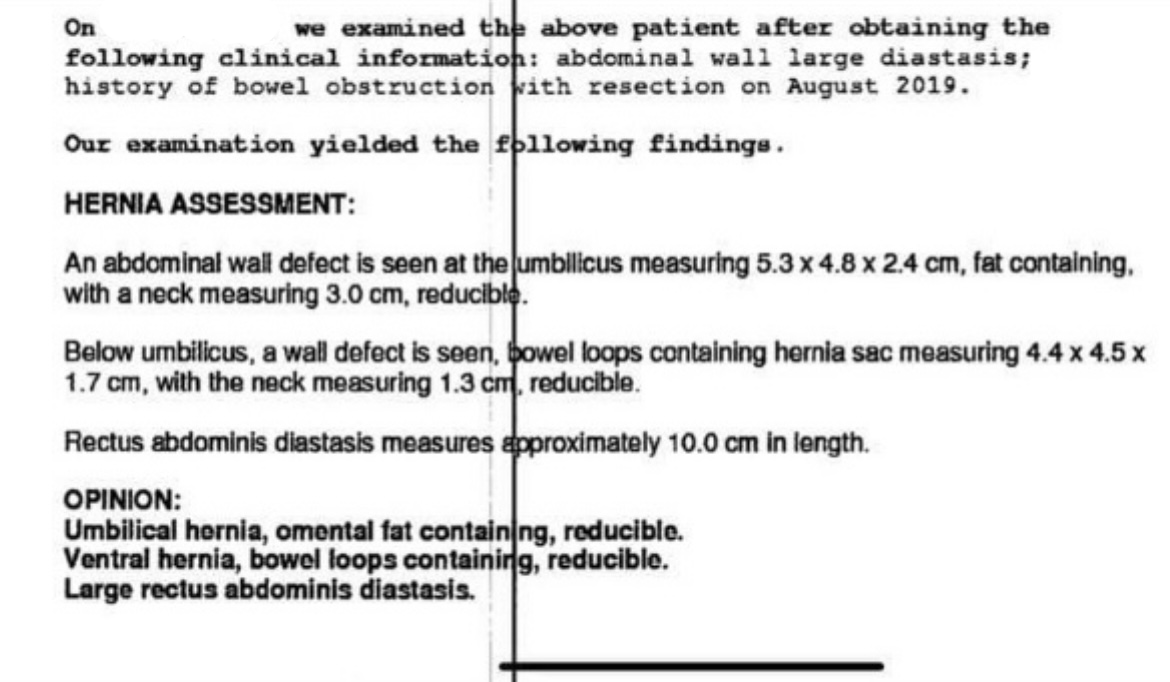
I met with a few surgeons to be sure I got multiple opinions. Once again, the recommendation was the same surgery; a total abdominal wall reconstruction with mesh. However, they weren't super positive about it, since I carry a higher risk of getting an infection. They admitted the surgery might not take away my abdominal pain. Furthermore, they explained that the surgery would likely last just 5-10 years. Since I was still in my 30s at the time, the idea of a surgery at least once every decade wasn’t super appealing to me. More surgery would also mean entirely new parts of my abs being cut for the first time...not something that sounded amazing.
To be honest, it was a pretty dark time for me. Surgery didn’t seem like a great idea, but I didn’t know what else to do. I decided to look and see what else was out there. After a lot of searching around online, I found my way to Core Exercise Solutions and the Diastasis Program which is now offered as part of the Applications Course. I had been trying out some free exercises from other sources that I had found on the internet, but they didn’t seem to be helping. I figured, if I was willing to pay for a surgery, I should be willing to pay for top notch exercise help as well!
The truth is, by this point I was feeling desperate. I had pain in my hernias with every breath, and pain every time I ate. I had already given up most of my favorite exercises and pastimes. As a personal trainer, my career was being affected, too. I wasn’t a lot of fun to be around since I needed help to do so many things, and I couldn’t be active without feeling a lot of pain. Being only in my 30s, all of this was utter craziness. I just wanted to be normal again!
And here’s the amazing part! After working the program for about six months, I was able to reverse my hernias – without surgery! This result was confirmed via ultrasound.
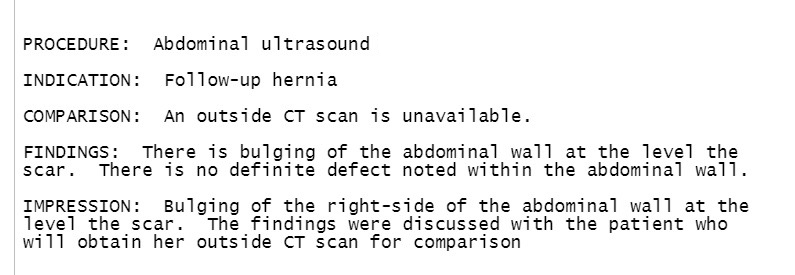
“Let me tell you, I was ecstatic when I walked out of that doctor's office. I had been told by a number of doctors that if I didn’t get the surgery, I would be resigning myself to doing little to no core work for the rest of my life, and certainly no heavy weight training or sports. I was also told that my hernias would get worse and worse over time. And none of that was true! I felt like shouting it from the rooftops when I got the good news. I was already feeling much better by the time I got the scan, which was great and made me suspect that the news would be pretty good, but seeing the proof before my eyes right there on that medical report was a moment where my whole world felt lighter and brighter.”
Core Exercise Solutions Was the Game Changer I Had Been Searching For
I worked the Applications Course for about six months between my diagnosis of 2 large hernias combined with a 10 cm long diastasis, and the diagnosis of no discernable defect in my abdominal wall. The exercises started off super easy. They gradually built up in challenge as I became ready for it. I felt comfortable and confident as I worked the program because I had the support of the incredible Facebook group that was part of the course.There I had access to experts who could check in with me about my form while I did the exercises. I was also surrounded by other supportive women focusing on healing similar issues! Finally, I didn’t feel alone in my struggle.
How I Got Started Helping My Umbilical Hernias Heal
One of the first things I learned how to do was cultivate a great 360 degree breathing pattern to help take the pressure off of my hernias that was preventing my body from healing them. You can try it out right now if you like!
After mastering a healthier breathing pattern to use throughout the day, I moved on to learning how to actively use my abs to bring the two sides of my rib cage closer together. The cool thing about an exercise like this is I also got to work on continuing to open up my tight back muscles – something that was preventing my body from being able to heal my hernias. This core exercise also happens to be super functional. We spend a lot more time in our day using our core while we are bending over to do a task than we do using our abs while we are on our back. Any practice that we do engaging our abs in this bent forward position is going to be really, really helpful for our healing.
Like many who have a hernia, I needed a little bit of extra work on expanding my back body. These two exercises helped my abs work better by setting them up in a better alignment to work. And by freeing up tight spots in my back, they helped me develop a more balanced core system which took pressure off my abdominal fascia as it was healing.
At the same time, I had work to do for narrowing my rib cage angle. It’s very common for folks with a hernia to have a rib cage angle that is wider than normal. This exercise made a difference quickly! Side note: I actually lost a size on my bra band after working on this! I never knew why my bra band size jumped up after my surgeries, and now it all makes sense. My ribs had expanded to a wider place than normal as a result of my surgeries, and I was able to reverse it with this exercise.
The last piece in the early days of my healing journey was to ensure that my scapula muscles were up to snuff. By increasing their strength to ensure they could show up for me during the day, pressure was taken off my diastasis and my hernias. This allowed my fascia to heal at a faster rate.
Taking My Hernia Healing to the Next Level
The next step for me was to learn how to use my abs to bring my rib cage toward my pelvis. I personally found that working on “crunches'' in a hands and knees position rather than on my back felt better on my diastasis and hernias at first. Your mileage may vary!
Once I mastered this, I began working on cross body exercises that helped knit my left side ribs toward my right side hip, and vice versa. This further helped my body to close up the hernias over time. Guess what we do every single time we take a step while walking? We use a cross body pattern (think – opposite arm swings forward of leg that steps forward). By cultivating that pattern with this exercise, I was able to turn everyday walks into hernia therapy! I don’t know about you, but I love a good multitask!
Another great find for me as I worked through the Applications Course was realizing how lacking my serratus anterior muscle was. Say what? Serratus? Even as a trainer, I had learned and quickly forgotten about this muscle; but it turned out to be a key for unlocking my healing puzzle. It connects our upper body to our abs, ensuring we have an efficient and highly capable system for all upper body tasks. We (should) use our serratus every time we go to reach for something. This exercise helps target it.
We can use the serratus strategically to help set our rib cage into a great position to help connect to our abs that much better. For me, when I tried this classic core exercise with a serratus reach compared to without one, it was night and day!
As I mentioned before, sometimes sneaky areas can be a culprit in preventing hernias from healing. Like many people, I benefited from doing some exercises to target my mid back. Our bodies are designed for our mid back to be mobile (meaning that it can move well), and our lower back is stable (meaning it’s good at preventing excess movement). However, if we have weak and/or locked up mid backs, then our lower back has to do extra work. This can lead to back pain and weaker abs as the system shifts away from what nature intended.
These next three moves helped bring my mid back mobility and strength to a new level. They require a good bit of core control, so if you have a hernia I recommend holding off on trying them until you have worked through some of the more basic breathing exercises for a bit.
Our Pelvic Floor is a Big Player in How Our Core Functions
Our pelvic floor muscles also do a lot to support our abs and any diastasis. After all, they are what holds us together from the bottom up! In the Applications Course, I learned how to tell if my pelvic floor was too tight or too weak for optimal functioning. I learned that tightness can mask strength. I also learned that…sneaky sneaky…tightness can come and go, so being able to tell what’s going on is critical. It turns out, kegels are the last thing some women should be doing – especially when they are new to core and pelvic floor work and they haven’t yet learned to manage pressure well. Who knew? Again, as a trainer who didn’t even know this, I feel bad for the layperson who is trying to figure it all out. It’s almost impossible without some expert help!
Release Work Can Be Your Secret Weapon to Help Hernias Heal
The other cool thing to know is that areas that don’t move well around the hernia can also influence how it feels and how it heals. When other areas don’t move well, it puts more pressure on the hernia.
In addition to corrective exercise, I did some tissue release work to help heal my hernias such as:
- skin rolling
- foam rolling
- depth of a dime release
- abdominal massage
Starting with the depth of a dime release is a good idea before trying some of the more aggressive techniques.
To do a “depth of a dime” release, take your fingers and push into the area you will be working on with just the depth of just a dime. From there, you can very gently pull your fingers one way and then the other (you’re pulling the skin, too). You can test out if pulling toward the direction of most resistance or toward the direction of least resistance results in the area feeling softer and more relaxed after you’ve finished. The goal is to feel better after you’ve done it than you did before.
Always be gentle when you have a hernia. Using a level 3 out of 10 tension is plenty. Start slowly, and see how your body responds. If all goes well, you can start working closer and closer to the hernia and you may also consider experimenting with the more aggressive forms of release such as skin rolling or cupping.
Watch out for pain in or around your hernia with any release work, either during or after the work. That’s a sign you need to back off.
A little-known fact about release work is that it tends to work best when we can do it frequently, which often isn’t available if we have to pay for and travel to a professional massage! I learned how to do all these forms of self-release work in the Applications Course. It’s so empowering and convenient to be able to do this kind of thing for yourself.
What I Had to Stop Doing
While healing, it’s not enough to work on the things you are supposed to do! I also needed to stop doing some things.
Since they put a lot of pressure on a hernia, I stopped these movements while I worked on rehab:
- pull ups
- push ups on my toes and from the floor (I don’t love calling them “guy” push-ups, but a lot of people know them that way!)
- heavier weight lifting
- running
Although I missed doing those exercises at the time, my patience paid off! As I got stronger, I was able to apply the principles of exercise I learned in my recovery exercises to these types of moves. After adding them back in, I felt stronger than ever! Now I feel so good and can do so much that I often forget I ever had anything wrong with my abs!
“I now have confidence that I won't ever again develop a hernia. Between the exercises and the techniques I learned for accomplishing daily tasks in a healthier way, my core feels bulletproof these days.”
I Believe This Could Work. But I’ll Admit… Just Getting Surgery Seems Like It Would Be Easier and Faster…
I get it – that is 100% your decision – and for some women, getting surgery is in fact the best option. However, realize that simply having hernia repair surgery, doing nothing else, and then hoping you’ll be fixed forever is not the way to increase your odds of success. In fact, the hernia repair failure rate is pretty high. (2)
Many patients are not exactly feeling warm and fuzzy about their experiences with hernias and their surgeons. I present to you the results of a worldwide online survey:
"A large group of ‘hernia surgery injured’ patients feel abandoned by their general surgeon when complications ensue."
Patients are craving more information about their hernia, surgical options, and quality of life concerns when seeking treatment for hernia (3). When I followed the Applications Course, I never once felt left alone or without enough information. The support the course offers is simply unbelievable.
I don't mean to scare you, but I would never, ever consider getting surgery without learning a healthier and more balanced way to work my core first. I would never consider having surgery without doing as much as I possibly could to set my system up for a successful outcome. You’ve probably heard that when someone is getting a knee replacement, it’s recommended that they build up their muscles as best as they can before going into the surgery. Our core works the exact same way. Corrective exercise can increase the odds that the surgery will “take” and decreases the odds of future issues developing. Doing these types of exercises can drastically increase your odds of continuing on with a pain-free, hernia-free life after surgery!
It's 100% worth taking some time to learn the right way to do these core exercises – whether you end up getting hernia surgery or not. When I first began working on the core exercises I learned from the Applications Course, I still kept the thought that I may have surgery one day in the back of my mind. I figured that by changing my pressure management and how my core system worked, I would at least get to a point where the required surgery would be smaller. But even if that wasn’t the case, I knew that the surgery would likely go better and last for longer if I had done this prep work. Now, you may have a smaller hernia than I had, and maybe you have only one hernia and not two – but a surgery is still a surgery. It’s a roll of the dice. I don’t know about you, but gambling with my body really stresses me out!
Don’t Visit a Surgeon Without These Questions in Hand
- Is there more than one type of surgery that could work for me?
- How much will it cost, including followup visits?
- Must I have mesh? What are the pros and cons of the different types of mesh?
- How many of this specific procedure you are recommending do you personally perform each year?
- What are the risks that come along with the surgery?
- What are the statistics on how many folks suffer a hernia in another area afterwards?
- What is the failure rate?
- What is the infection rate?
- Will there be a hospital stay?
- If I get surgery, how long are my restrictions, and what are they?
- What are the conservative options?
- What happens if I just do nothing?
I recommend showing up with an actual list of questions. Don’t leave until you have them all answered. Surgery is a big deal!
If you end up having the surgery (which is a good and sometimes necessary option for many women) you’ll want to prep your body as best as you can with corrective exercise first. You’ll also want to dive back into them again after you get clearance for exercise by your doctor. I am positive that if I had known about these exercises after my own intestinal surgeries, I could have saved myself a lot of heartache!
What Life is Like Once You’ve Healed from a Hernia
Before I healed my hernia, I had to tape my abdomen tightly with KT tape (which later I learned in this program is not a great idea – if you need tape, it is best to avoid putting it on stretch) just to get through my day. I lived in fear that anything I was doing could potentially make my hernia worse. Moving that couch? Forget it. Sneezing? Eeek. Sexy time? Dicey, at best.
I was petrified to work my core, since the doctors I met with scared me into believing my hernia would only get worse and worse with time. All of that is in my rearview mirror now! I am doing what I want to do, without fear, and it feels amazing.
Now I am so tremendously confident in doing anything I want to do that I often forget my hernias were even there! It’s no longer present in my mind 24/7. The hernia repair exercises I performed to achieve this result were simple, and easy to incorporate into my day. I can even do some of them while in the car or waiting in line at the grocery store. Now that I am healed, I am on a maintenance plan with the exercises and it's not a big deal at all to keep up with them while I focus most of my time on other types of workouts.
How Getting a Hernia Was My Blessing in Disguise
As you learn about improving your hernia, you will learn so much more than you bargained for. You will see why a hernia is often a full body issue with the hernia being a symptom.
Along the way you will learn about:
- managing back pain
- help for SI joint pain
- shoulder and neck relief
- improved posture
- closing diastasis
- improving prolapse
and many other issues that can affect us from head to toe, and often are closely related to why you developed the hernia in the first place.
A lot of these issues can be drastically helped with a few simple breathing exercises that are easy to fit into your day. It's pretty amazing stuff! (4) So much can go wrong when our core is weak or injured or things are simply out of balance in our body. The good news is that many others before you have broken free from feeling like their bodies have failed them. They have retrained their body to function once again as nature intended. You could be next!
After working on the exercises I’ve shown you already, I was able to advance to more challenging ones and heal my hernias once and for all! I learned all of these exercises in the Core Exercise Solutions Applications Course, which is premised on video-based learning. You can watch and follow the videos on your own time, and full support is available. No driving to appointments or paying copays for tons of visits. And the best part is, working on programs on your own at home has been proven to be just as successful as in-person options (5).
The Applications Course covers helping your body function at its best from head to toe. By utilizing a full body approach, it gives you the best possible chance of fixing your hernia naturally. There are also KT tape or Rocktape techniques you can try to aid in healing. You can learn all about taping techniques as well as other forms of self-release work by joining the Applications Course.
Let me tell you – I saved so much money learning how to exercise best for my own body with this program as well as learning how to perform my own release work on tight muscles. Constant visits to chiropractors and massage therapists became a thing of the past!
References:
(1) Brown A, Abrahams S, Remedios D, Chadwick SJ. Sports hernia: a clinical update. BR J Gen Pract. 2013:(608):e235-7. doi: 10.3399/bjgp13X664432 Available at: https://www.ncbi.nlm.nih.gov/pmc/articles/PMC3582984/
(2) Deerenberg EB, Timmermans L, Hogerzeil DP, Slieker JC, Eilers PH, Jeekel J, et al. A systematic review of the surgical treatment of large incisional hernia. Hernia J Hernias Abdom Wall Surg. 2015;19(1):89–101. doi: 10.1007/s10029-014-1321-x. Available at: https://pubmed.ncbi.nlm.nih.gov/25380560/
(3) Front. Surg., 24 December 2021 | Patient Views Around Their Hernia Surgery: A Worldwide Online Survey Promoted Through Social Media Barbora East, Susannah Hill, Nicola Dames, Sue Blackwell, Lynn Laidlaw, Hakan Gök, Cesare Stabilini and Andrew de Beaux Department of General Surgery, Royal Infirmary of Edinburgh, Edinburgh, United Kingdom 3rd Department of Surgery, Motol University Hospital, Prague, Czechia Patient Representative, London, United Kingdom Patient Representative, Glasgow, United Kingdom Patient Representative, Liverpool, United Kingdom Hernia Istanbul®, Hernia Surgery Center, Istanbul, Turkey DISC (Department of Surgical Sciences), University of Genoa, Genoa, Italy. https://doi.org/10.3389/fsurg.2021.769938Available at: https://www.frontiersin.org/articles/10.3389/fsurg.2021.769938/full?&utm_source=Email_to_authors_&utm_medium=Email&utm_content=T1_11.5e1_author&utm_campaign=Email_publication&field=&journalName=Frontiers_in_Surgery&id=769938&fbclid=IwAR0l3Bwk8dzVtJwv2riNSucLhhYkn3nb30i37jYiphosUiJgXMweQXqvWP8
(4) The functions of breathing and its dysfunctions and their relationship to breathing therapy. Rosalba Courtney. RMIT University, School Health Science, 11 Binburra Ave, Avalon, N.S.W. 2017, Australia Available at: https://respirasbreathing.com/documents/breathing/Breathing%20therapy%20Functions%20of%20Breathing%20Australia.pdf
(5) 4. Evaluation of self-administered tests for pelvic girdle pain in pregnancy. Monika Fagevik Olsén, Helen Elden & Annelie Gutke. BMC Musculoskeletal Disorders volume 15, Article number: 138 (2014) Available at: http://www.biomedcentral.com/1471-2474/15/138
Related Articles:
https://www.coreexercisesolutions.com/3-steps-to-fix-a-diastasis-recti/
https://www.coreexercisesolutions.com/how-to-heal-a-diastasis-recti-without-surgery/
https://www.coreexercisesolutions.com/c-section-reasons-risks-recovery/
Pelvic Floor and Diastasis Recti Course (Professionals)
What You Need to Know About Pressure Management
Cost: Free | Length: 1.5 hours
Working with pregnant and postpartum clients/patients?
This 6-part course offers key takeaways on breathing, pelvic floor strengthening and diastasis recovery. Sign up and start learning today!
Improve Your Core and Pelvic Floor Webinar
Proximal Versus Distal Hamstrings, Pelvic Floor Contractions and Decreasing Pelvic Floor Tightness
Cost: Free | Length: 27 minutes
This webinar provides a breadth of knowledge for professionals in a self-exploratory way. We walk through several exercises designed to improve pelvic floor and core function.
About the Author
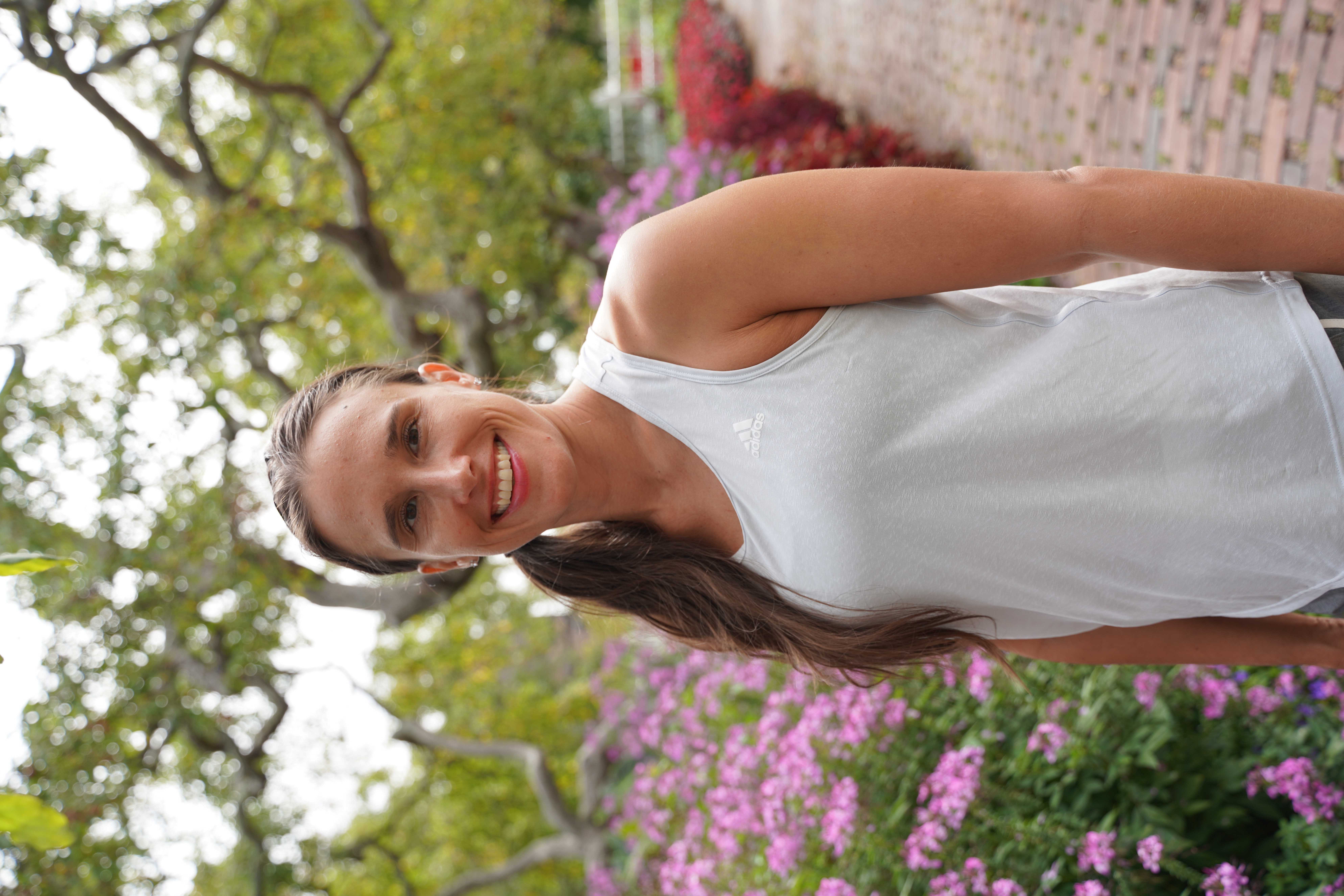
This is a guest post written by Gina Paulhus. She is the owner of Home Bodies in home fitness training, and she meets with clients virtually as well as in person. She is an ISSA Certified Personal Trainer and Certified Nutritionist. She is a two-time author. Gina is a PCES graduate and especially enjoys helping people overcome hernias and diastasis non-surgically. She competed in gymnastics up until age 35. She loves helping gymnasts of all ages maximize their core and hip strength as well as their pelvic floor health. Gina’s favorite pastimes include hiking and hanging out at the beach. Her website is http://HomeExerciseCoach.com.

